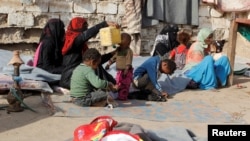More than 30 million people were displaced within their own countries last year, says a new report.
The Internal Displacement Monitoring Center and the Norwegian Refugee Council cite conflict, criminal violence and natural disasters as the driving force behind the uprooting of tens of millions.
“When a family is pushed out of their home, sometimes for years, it is a sign something is wrong in a nation, the locality, but also in international relations,” Norwegian Refugee Council Director-General Jan Egeland told reporters at the launch of the report Monday.
Nearly seven million people were newly displaced last year alone.
The Democratic Republic of Congo topped the list of conflict-driven dislocation, with more than 922,000 new IDPs in 2016, exceeding Syria and Iraq, which came second and third, respectively.
Egeland said North and South Kivu and Kasai province were responsible for much of the displacements. He said despite a massive international presence in eastern Congo, the United Nations has its largest peacekeeping mission there with 22,000 troops and police, funding for humanitarian appeals has dwindled and the Congo’s problems have fallen off the top of the international agenda.
The other countries topping the list were Syria (824,000 displaced), Iraq (659,000), Afghanistan (653,000), Nigeria (501,000) and Yemen (478,000).
“In 2016, one person every second was forced to flee their home inside their own country,” Egeland said. “Internally displaced people now outnumber refugees by two to one,” he added.
"We need to acknowledge that without the right kind of support and protection, a person internally displaced today may become a refugee, an asylum seeker or an international migrant tomorrow," said Alexandra Bilak, IDMC director.
Criminal violence is fueling displacement in places like Central America, where drug violence caused more than 200,000 new movements in 2016 in El Salvador.
Storms, floods, drought, wildfires and other natural disasters are also forcing people from their homes. The numbers are on the rise, with three times as many people displaced due to these factors in 2016 than in 2015. Researchers fear these figures will grow as countries cope with climate change and more extreme weather events.
Bilak said the international political response and funding is not in line with the needs and must be dramatically scaled up.






